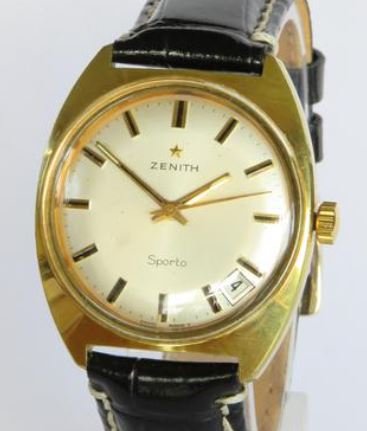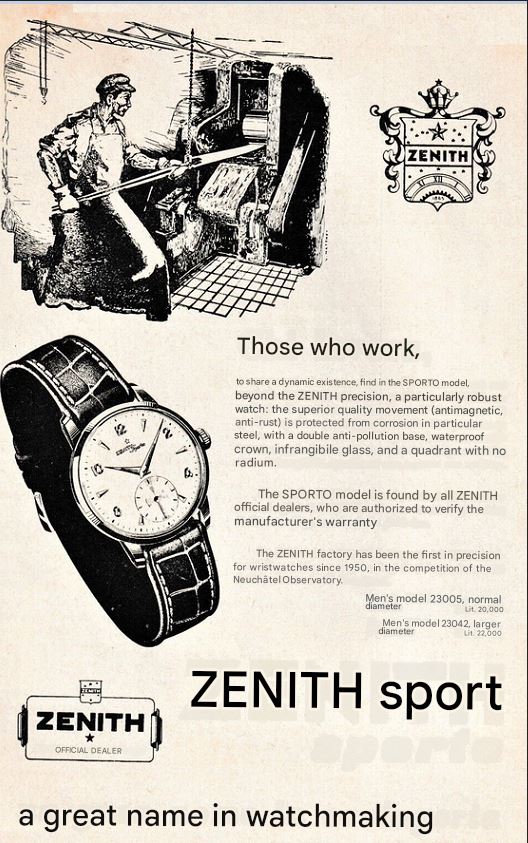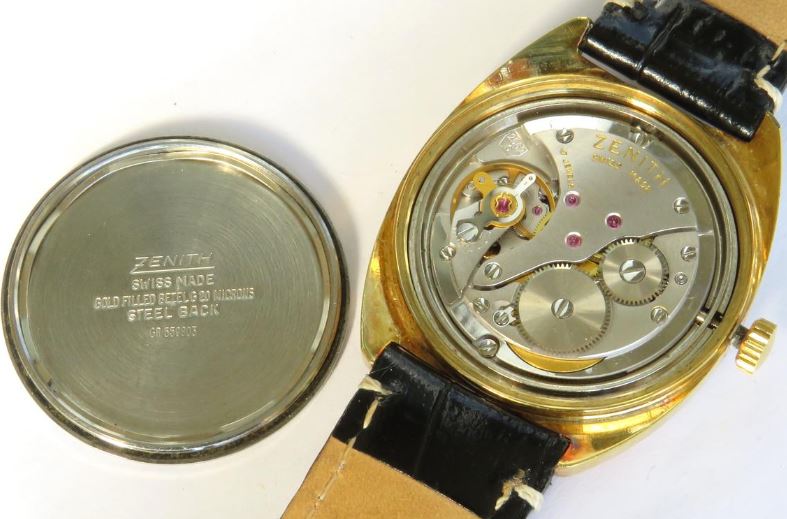Zenith is a brand that rarely appears in these pages. There is a reason for that, which we will discuss further down the page. That said, this post is about a vintage Zenith Sporto wristwatch dating from the 1970s. It caught our eye and our interest. Although the watch was sold before any of us considered buying it, we were inspired to research the Sporto range, and here is what we found.

A brief history of Zenith
In 1865, the 22-year-old Georges Favre-Jacot laid the groundwork for what would become Zenith in Le Locle, Switzerland. He revolutionised the industry by bringing all aspects of watchmaking under one roof, creating a unified factory where skilled craftsmen worked together. This modern approach led to the more efficient production of high-quality watch movements. The company, initially known as Fabrique des Billodes, was renamed Zenith in 1911. The new name was inspired by the astronomical term for the highest point in the sky, reflecting Favre-Jacot’s aspiration for the brand to reach the pinnacle of watchmaking excellence (Zenith at Watch Wiki).
Zenith’s dedication to precision quickly won them a stellar reputation. In 1909, their watches made history on the wrist of aviator Louis Blériot during his legendary flight across the English Channel, cementing the brand’s place in aviation. Throughout the early 20th century, Zenith’s chronometers were highly sought after, securing multiple awards at observatory trials and helping the company expand its reach globally (Louis Blériot at Zenith).
El Primero
In 1969, Zenith launched the El Primero, a groundbreaking automatic chronograph movement that operated at a high frequency of 36,000 vibrations per hour, allowing it to measure time with incredible accuracy down to 1/10th of a second (El Primero at Watches of Switzerland). However, the 1970s brought the Quartz Crisis, which challenged many traditional Swiss watchmakers, including Zenith. The company adapted by introducing quartz models and paused production of the El Primero in 1975 to survive the downturn.
As mechanical watches regained popularity in the 1980s, Zenith reintroduced the El Primero to great acclaim (The fall and rise of Zenith at Grail Watch). The company was acquired by the luxury giant LVMH in 1999. Today, Zenith continues to be a respected name in high-end watchmaking, celebrated for its robust precision and the iconic El Primero movement. Zenith remains a brand that skilfully blends its heritage with a constant focus on innovation.
The Zenith Sporto
First introduced in the late 1940s, the Sporto was one of Zenith’s longest-lasting ranges. According to Chronopedia, it was in direct competition with Omega’s Seamaster dress watches, which were first introduced in 1948. The Zenith Sporto line was marketed as a durable, everyday watch with a focus on reliability. The Sporto was meant to blur the line between sporty practicality and dress-watch refinement. It made the range versatile companions for both casual and formal wear.
The Sporto range really hit its stride during the 1950s with classically designed models featuring both black and ivory dials. The initial Zenith Sporto watches featured reliable manual-wound movements. An automatic option was introduced in the 1960s. Though the overall appearance remained essentially the same, the automatic watches were thicker to accommodate the additional winding mechanism. The automatic models were branded ‘AutoSport’ on the dial, making it easy to tell them apart. It is worth noting that the manually wound Sporto models continued throughout the entire production cycle.
Production of the Sporto range continued well into the 1970s, with later models being fitted with Zenith’s excellent high-frequency (28,800 vph), calibre 25xx range of movements. These models generally feature “28800” on the dial. It is thought that the Sporto and AutoSport models were retired in the mid-1970s in favour of the Defy range, although both ranges were produced simultaneously for a short period.
Marketing
The Zenith Sporto was marketed as a practical, robust watch, perfectly suited to work or sporting activities. Advertising material promoted the following features: Antimagnetic, Shock-proof, Dust-proof, Chrome-plated metal case, stainless steel back and elegant and precise.

There were a number of Sporto variants. Most had circular cases, but some versions were produced with a tonneau case. Dial colours include white, champagne, silvered, grey, blue and black. The range included hand-wound and automatic versions. There were also chromograph editions.
The range was largely sold through authorised Zenith dealerships, but in the UK, some models were dual-branded with the names of the retailer. Examples of this included: Pidduck & Sons of Market Square in Hanley and Davidson & Sorley of Glasgow.
Zenith calibre 2562C
The movement is a Zenith calibre 2562C. It is a 17-jewel manual-wind movement, with sweep second and date function. The 2562 was in production from circa 1970 to 1975. It was a high-frequency movement with 28,800 vph and has Incabloc shock protection.

According to Emmy Watch, the 2562C features an early form of quickset date where the hands are moved backwards and forwards between 12 midnight and 6 pm. This is repeated until the desired date is reached (or just continuously turn the hands forward).
Dial
The silver dial has applied Arabic hour markers and an offset date window. The dial is original and is in good condition with age-related patina. The Lume plots have aged to a nice tone. The hour markers have some corrosion marks. The hands are original with period Lume in-fill. Overall, they are in good condition with some slight corrosion marks. The crystal is original and is in good condition with only some slight scratches. It comes with the original Zenith buckle on a new strap. Original pin-buckles are a rarity on vintage watches, as the buckles are often discarded when a leather strap is changed.
Sporto case
Zenith’s Sporto range was produced with an extremely good quality steel casing, featuring sharp angles and edges and combinations of satin and polished finishes. The outside case back is solid steel, but the movement is covered by an additional glazed cuvette. This enhances the protection of the movement from dirt and moisture, and also allows inspection of the movement without opening its casing. The watch measures 33mm wide, excluding the Signed Zenith winding crown, and 33mm high, excluding the lugs. The case is gold-plated, and it is in good condition. Stainless steel screw-on case back.
Why not Zenith?
In casual conversations amongst the Set Back in Time team, the Zenith name doesn’t come up very often, quite possibly because none of us have ever owned a Zenith. But why? Zenith makes good-quality watches, but they don’t seem to capture the imagination quite like other brands.
Marketing is a big reason. Zenith struggled to achieve a decent market share in the United States, which was down to a naming dispute with the Zenith Radio Company. This made it difficult for them to get a foothold in a major market.
Also, it’s quite common for watch collectors to chase the bigger, more well-known brands such as Rolex, Omega, AP, or Patek. Because of this, brands like Zenith, Longines, or IWC often get overlooked, as people don’t fully appreciate how excellent their watches truly are. That said, some of Zenith’s movements, such as the famous El Primero, were so well regarded that other brands, including Rolex, sourced them for their own timepieces, which certainly breathed new life into the Zenith brand.
I suspect that one day, one of us will indulge in a vintage Zenith, and only then will our appreciation grow. Perhaps, that timepiece might well be a Zenith Sporto. Time will tell.
Leave a Reply